Targets
What are the different types of targets?
In every job, accuracy comes down to proper targeting. Targets are the link between measuring systems and the physical world – they transform an object's physical position into a form recognizable by a metrology instrument. They are placed in, on, or around important details of whatever is being measured, such as part of a machine, tool, airframe, or virtually anything else. The measuring instrument is then capable of locating and/or measuring the location of the target, thereby deducing the physical location of the related detail on the tool or machine. The related category of target holders is equally important. These are "in-between" products – they hold the target in a manner which is appropriate for measuring various details. These products are all made quite precisely because the relationship of the target to the actual physical detail must be known very accurately.
We make and sell all sorts of targets and target holders. The table below offers a short description of the various types in two major categories, 3D Measurement and Alignment type (Optical Tooling).
Line spacing on alignment targets

Many of our alignment targets have paired line target patterns. This type of pattern provides you with optimal visual acuity when centering your reticle on a downrange target. Remember however that the target spacing must be roughly correlated to the shot distance. If you use a target with narrow spacing at a long distance, the reticle in your instrument may cover up not only the gap between the pair of lines but also the lines themselves. Likewise, if you use a wide spacing on a target that is close to the instrument, there will be too much gap showing, and the reticle line will appear too narrow to give you the needed visual cues to center on the target. To solve this problem, some of our targets have multiple paired lines, with several different line spacings all on the same target. These targets may be used at a variety of distances. A simple rule of thumb is illustrated by the chart below. The rule says that optimally, you should have a line spacing of about 0.001" per 1 foot of shot distance. You should note that this is a general rule to assist you in getting the optimum accuracy from your system. That being said, there is "leeway" in the rule; you can vary somewhat from these values as long as you don't stray too far.
For 3D Measurement Systems
 |
Scale targets are printed on Brunson scale material, and provide a target pattern at a precisely known distance from the reference end of the scale. These are often used in conjunction with our Invar Kits to create known calibration artifacts for 3D measuring instruments, such as theodolite systems. |
 |
Laser Tracker Target Holders aren't really targets per se, but are used to hold laser tracker targets (Spherically Mounted Reflectors, a.k.a. Corner Cube Reflectors) in precise locations relative to important points on objects being measured. These adapters are used to position laser tracker targets on edges, in corners, on hole centerlines, and in may other positions so that accurate measurements may be taken. |
 |
Retroreflective targets have a highly reflective dot centered at a precise distance from the bottom interface surface of the target. Photogrammetric measuring systems as well as some laser scanning instruments pick up on the highly reflective dot and are able to use it as the measurement reference artifact. |
For Alignment (Optical Tooling)
 |
Adhesive or "sticker" targets are used for temporary placement of reference points for a variety of reasons. These targets are often used as transient reference points in alignment jobs, to hold reference elevations or lines of sight, provide transfer points for theodolite-based 3D measuring systems, or for field instrument testing. They are available in various target patterns, including a graduated pattern. |
 |
Disk targets are translucent plastic to allow backlighting; (however some are aluminum). Backlit targets are very convenient to use as the last (far) target in a bore alignment – they act as a good diffuser for all of the other targets. Two A.I.A. standard diameters are available; 1.500" and 2.250". They are often used with bore target kits or as mentioned above in multiple target alignments. Use them in custom-made sleeves for specialized bore alignment applications. The 2.250" targets may be mounted in our spherical adapters. |
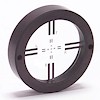 |
Glass targets have a target pattern imprinted on a glass substrate, allowing for easy backlighting. These targets are available with or without the steel ring.Care should be taken if this type of target is used as an intermediate target in a line of several targets; refractive error can creep into the measurements if not absolutely orthogonal to the line of sight. For those applications, see "Open" targets below. |
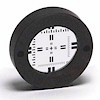 |
Graduated targets are similar to glass targets, but have an additional "scale-type" register imprinted on the glass substrate. This provides additional range for alignment measurements by effectively extending the measuring range of an optical micrometer. They are often used in bore alignments where this added flexibility can be a real advantage. |
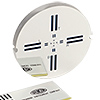 |
Mirrored targets have a pattern which is imprinted on a first-surface mirror and may be used whenever an instrument's line of sight must be established perpendicular to the target's surface as well as aligned with the target pattern. For example, they may be used when trying to bring an instrument's line of sight collinear with a rotating axis. The mirror allows autocollimation and the target pattern allows "bucking in" to the center of the end of the relevant axis. |
 |
Open or "wire" targets use only wires or other material in the center (no glass). They are used for bore sighting or any application where several targets must be placed on the same line of sight. They are often used on turbines or other power generation equipment, engine blocks or machinery having multiple bearing journals; or any application requiring evaluation of sequential bores. The open center allows you to focus from one target to the next with minimal distortion. A.k.a. "see-through" targets. (Note that glass targets are not included in this category, even though you can see through them as well.) |
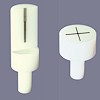 |
Plug and socket targets are multipurpose targets used in alignment or 3D measurement, by instruments employing visual optics such as optical tooling or theodolites. They are often used to hold offset reference lines for roll alignments or to establish reference directions using floor monuments or other target holders. Various configurations allow the targets to be viewed end-on, side-on, or at 45°. A number of target patterns are available including single cross, multi-paired line, bull's eye. |
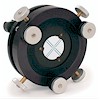 |
A Spindle mirror has a mirrored target integrated into a special translating and tilting base. This is specifically designed to be used with alignment instruments like theodolites or optical tooling. It is made to fit mechanically or magnetically on the end of a rotating shaft, and to allow an instrument to be adjusted parallel to the shaft axis, or collinear with it. |














